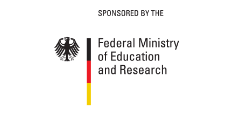The ENTERVENTIONALE is the first joint project of the Museumsstudien Bonn and, as an interdisciplinary exhibition trail, links the university, museums, cultural institutions and off-spaces of the city. Under the motto EVERYTHING IS NOW, contemporary artists will enter into a dialogue with historically influenced collections, reformulate places in the city or reformat them with sound installations for the Beethoven anniversary in 2020.
Landmark
In its original function, the routing or warning tape, as it is also called, is used to spatially close off operational and hazardous areas - as a visual warning and marking of places not to be entered. In road construction or on construction sites it commands "Stop!", "Do not go any further", "Danger". However, this message is rather unusual for a museum, after all, the premises are meant to be explored and new insights gained.
In his "Landmark" series, which the artist has been pursuing since 2016, Uribe-Castro temporarily intervenes in certain places. In doing so, he consciously uses the warning signal familiar to us as a sign of change to make us pause. The "Landmarks" are therefore primarily used in public buildings in order to (re)focus on their historical and/or political background.
Oh Jehova, quam ampla sunt tua opera!
Because of the golden writing in the foyer of the museum, "Oh Jehovah, how numerous are your works" (Psalm 104:24), he initiated an exchange between the Castle Church of the University and the Museum Koenig: For a period of six weeks, bird specimens - from the Andean condor to the golden cuckoo - moved into the classicist church building from the Age of Enlightenment. In this way Uribe-Castro brings species into the sacred space that are threatened due to direct human decimation or the consequences of our way of life: Oh my God, how many works of art are there?
At the respective exhibition locations, replicated wire birds have moved in within the museum tour, clothed under fabric. On the one hand, the hanging cloths are reminiscent of the depots of deposited objects or of houses that have been abandoned after the death of their owners. On the other hand, in religious contexts, figures of saints or crosses are covered with cloth at certain times, thus denying the faithful the sight of them, in order to recall their meaning and emphasize it when they see them again. The sacred is the sacred, the non-touchable or touchable: touche pas. C'est sacré. "Jehovah's works" do not seem sacred enough to us-or only when they die as preparations or veiled shadows.
Roberto Uribe-Castro
Uribe-Castro's work for this ENTERVENTIONALE diametrically connects the places and institutions, the Research Museum Koenig and the Castle Church. The selected animals carry different symbolic meanings for the artist personally on the one hand and culture-specific on the other. Thus the Andean Condor transports Indian values whose meaning is deeply connected with the formation of the earth. According to Uribe-Castro, these are values that should carry necessity, especially in current climate and environmental debates.
Uribe-Castro asks what we believe in. He questions our values and tries to evoke emotions through blank spaces that remind us in which world and by which standards we want to live. He formulates: "The connection between the two places forces the public to move between different spaces. Each of them corresponds to a different vision and understanding of the world. But today, given the urgency caused by natural disasters, among other things, it is more about what connects us than what divides us."
Roberto Uribe-Castro, born 1974 in Bogotá, Colombia, currently works and lives in Berlin.
Worldwide dramatic challenges - from climate change to environmental pollution and extinction of species - are the themes of Uribe-Castro's international installations and other interventions.








